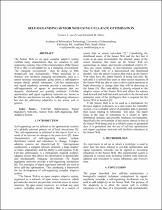JavaScript is disabled for your browser. Some features of this site may not work without it.
- ResearchSpace
- →
- Research Publications/Outputs
- →
- Conference Publications
- →
- View Item
| dc.contributor.author |
Van Zyl, TL

|
|
| dc.contributor.author |
Ehlers, EM

|
|
| dc.date.accessioned | 2009-06-04T14:14:54Z | |
| dc.date.available | 2009-06-04T14:14:54Z | |
| dc.date.issued | 2009-07 | |
| dc.identifier.citation | Van Zyl, TL and Ehlers, EM. 2009. Self-organising sensor web using cell-fate optimisation. IEEE International Geoscience and Remote Sensing Symposium (IGARSS), Cape Town, South Africa, 12 - 17 July 2009, pp 2 | en |
| dc.identifier.uri | http://hdl.handle.net/10204/3421 | |
| dc.description | IEEE International Geoscience and Remote Sensing Symposium (IGARSS), Cape Town, South Africa, 12 - 17 July 2009 | en |
| dc.description.abstract | The Sensor Web as an open complex adaptive system exhibits many characteristics that are common to self organising systems. One of the characteristics of the Sensor Web is that of self-adaptivity in a changing environment. The changing environment may be doing so both dynamically and stochastically. When presented by a dynamic and stochastic changing environment, such as a sensor resource unexpectedly going down, a self-adaptive system should exhibit robustness. Cell-fate optimisation and signal regulatory networks provide a mechanism for self-organisation of agents in environments that are dynamic, distributed and possibly stochastic. Cell-fate optimisation and signal regulatory networks are shown to be effective mechanisms not only for addressing robustness but also for addressing adaptivity in the sensor web in general | en |
| dc.language.iso | en | en |
| dc.relation.ispartofseries | Workflow request; 1531 | |
| dc.subject | Sensor web | en |
| dc.subject | Cell-fate optimisation | en |
| dc.subject | Signal regulatory networks | en |
| dc.subject | Self-adaptive system | en |
| dc.subject | IEEE International Geoscience and Remote Sensing Symposium | en |
| dc.subject | IGARSS 2009 Conference | en |
| dc.subject | Geoscience | en |
| dc.subject | Remote sensing | en |
| dc.subject | Earth observation technologies | |
| dc.title | Self-organising sensor web using cell-fate optimisation | en |
| dc.type | Conference Presentation | en |
| dc.identifier.apacitation | Van Zyl, T., & Ehlers, E. (2009). Self-organising sensor web using cell-fate optimisation. http://hdl.handle.net/10204/3421 | en_ZA |
| dc.identifier.chicagocitation | Van Zyl, TL, and EM Ehlers. "Self-organising sensor web using cell-fate optimisation." (2009): http://hdl.handle.net/10204/3421 | en_ZA |
| dc.identifier.vancouvercitation | Van Zyl T, Ehlers E, Self-organising sensor web using cell-fate optimisation; 2009. http://hdl.handle.net/10204/3421 . | en_ZA |
| dc.identifier.ris | TY - Conference Presentation AU - Van Zyl, TL AU - Ehlers, EM AB - The Sensor Web as an open complex adaptive system exhibits many characteristics that are common to self organising systems. One of the characteristics of the Sensor Web is that of self-adaptivity in a changing environment. The changing environment may be doing so both dynamically and stochastically. When presented by a dynamic and stochastic changing environment, such as a sensor resource unexpectedly going down, a self-adaptive system should exhibit robustness. Cell-fate optimisation and signal regulatory networks provide a mechanism for self-organisation of agents in environments that are dynamic, distributed and possibly stochastic. Cell-fate optimisation and signal regulatory networks are shown to be effective mechanisms not only for addressing robustness but also for addressing adaptivity in the sensor web in general DA - 2009-07 DB - ResearchSpace DP - CSIR KW - Sensor web KW - Cell-fate optimisation KW - Signal regulatory networks KW - Self-adaptive system KW - IEEE International Geoscience and Remote Sensing Symposium KW - IGARSS 2009 Conference KW - Geoscience KW - Remote sensing KW - Earth observation technologies LK - https://researchspace.csir.co.za PY - 2009 T1 - Self-organising sensor web using cell-fate optimisation TI - Self-organising sensor web using cell-fate optimisation UR - http://hdl.handle.net/10204/3421 ER - | en_ZA |






